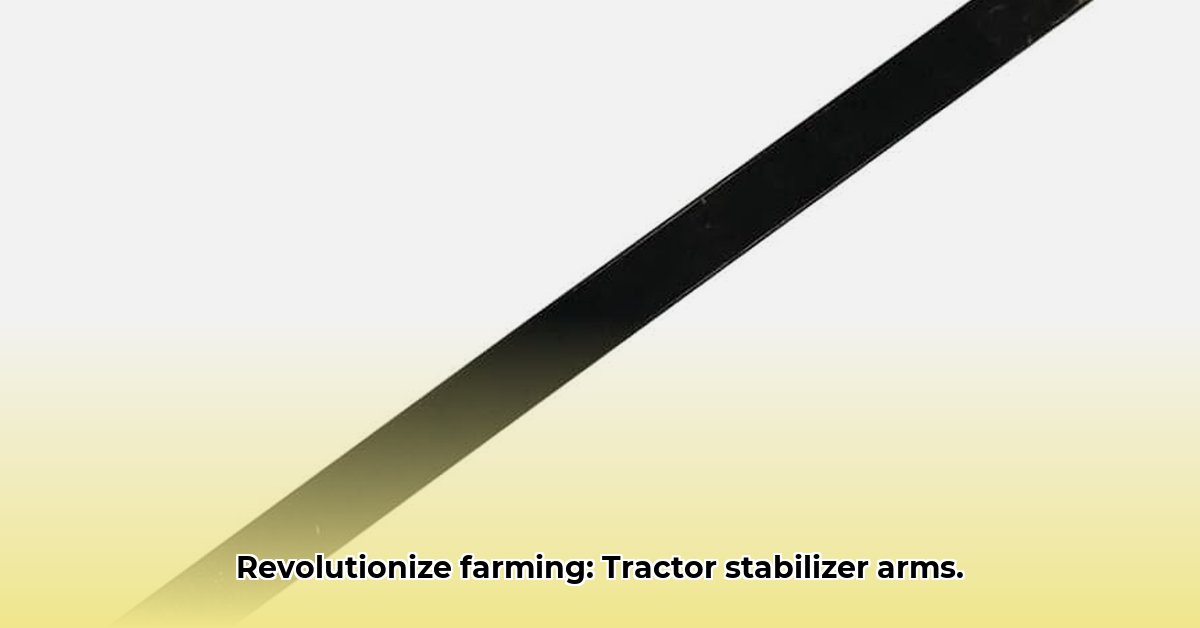
Understanding Tractor Stabilizer Arms: A Comprehensive Guide
Tractor stabilizer arms are essential tools for modern sustainable farming, enhancing precision and efficiency while minimizing environmental impact. This guide provides a practical, step-by-step approach to understanding, installing, maintaining, and troubleshooting these valuable attachments. We'll explore various types, highlighting their applications and benefits in optimizing your farming operations. Don't let uneven terrain or implement drift hinder your yields; learn how stabilizer arms can help you achieve peak performance and environmental stewardship. For more advanced leveling solutions, check out this helpful resource.
Types of Tractor Stabilizer Arms: Choosing the Right Fit
Several types of stabilizer arms cater to different tractor models and farming needs. Understanding these variations is crucial for selecting the optimal solution for your operation. The wrong choice can lead to inefficiencies and potential damage.
Fixed Arms: These robust and cost-effective options are suitable for less demanding operations and provide consistent support. Their simplicity translates to easy installation and maintenance.
Adjustable Arms: Offering greater flexibility, adjustable arms adapt to diverse terrains and farming scenarios. Their adaptability is invaluable for operations involving varying ground conditions and tasks.
Hydraulic Arms: These advanced systems provide superior control and smoother operation, particularly beneficial for precision tasks like specialized crop spraying and delicate planting. Their precision enhances accuracy and minimizes resource waste.
Selecting the right type depends on your specific needs and budget. Consult your local agricultural equipment supplier for personalized advice tailored to your tractor model and farming practices. What factors are most important to you when choosing farming equipment? Cost, ease of use, and precision are often top contenders.
Installing and Maintaining Your Tractor Stabilizer Arms: A Step-by-Step Guide
Proper installation and regular maintenance are essential for optimal performance and longevity of your stabilizer arms. Careful adherence to the manufacturer's instructions is crucial. Improper installation can severely compromise performance and even cause damage.
Step 1: Preparation. Ensure your tractor is safely parked on level ground with the engine off. Gather all necessary tools and consult the manufacturer's instructions.
Step 2: Attachment. Carefully align the stabilizer arm brackets with your tractor's 3-point hitch, ensuring a snug fit. Correct alignment is critical for stable operation.
Step 3: Securing. Securely tighten all bolts according to the manufacturer's specifications. Using the right torque is crucial to prevent premature wear and tear.
Step 4: Testing. Slowly lift and lower the implement to check for stability and smooth operation. Identify and correct any issues before fully integrating the arms into your workflow.
Step 5: Regular Inspection. Regularly inspect the arms for wear, damage, or loose components. Address issues promptly to avoid costly repairs.
Regular maintenance extends the lifespan of the stabilizer arms, reducing long-term costs. This includes lubrication of moving parts and fluid checks (for hydraulic arms), as recommended by the manufacturer. What preventative maintenance steps do you typically take for your farming equipment? A proactive approach is key to avoiding unexpected downtime and expense.
Benefits of Tractor Stabilizer Arms for Sustainable Farming
Tractor stabilizer arms provide significant advantages in various aspects of sustainable agricultural practices:
Reduced Resource Consumption: Precision application of inputs (fertilizers, pesticides, seeds) minimizes waste and reduces environmental impact. This directly translates to cost savings and environmental stewardship.
Improved Soil Health: Consistent implement depth minimizes soil compaction, maintaining soil structure and promoting water infiltration and nutrient cycling. Healthy soil is the bedrock of sustainable farming.
Increased Efficiency: Reduced lateral movement increases fieldwork speed and efficiency, leading to improved productivity and reduced fuel consumption.
Enhanced Safety: Stabilized implements improve operational safety, reducing accident risks and protecting both the equipment and the operator.
How much can improved precision reduce fertilizer use? Studies show that precision agriculture techniques can reduce fertilizer application by up to 20%, significantly reducing environmental impact and costs.
Troubleshooting Common Problems with Stabilizer Arms
While generally reliable, stabilizer arms can encounter occasional issues. Prompt identification and resolution are crucial to minimizing downtime.
Hydraulic Leaks: This usually signals a problem with hydraulic lines or seals. Consult a qualified mechanic for diagnosis and repair.
Arm Movement Issues: Bent or damaged components are often the cause. Careful inspection should pinpoint the area requiring attention.
Insufficient Stability: This may indicate incorrect installation or adjustment. Review the installation procedure and manufacturer instructions.
What is your biggest challenge in maintaining your farming equipment? For many farmers, promptly diagnosing and fixing issues is a top priority.
Cost-Benefit Analysis: Investing in Tractor Stabilizer Arms
The initial investment in stabilizer arms will vary. However, the long-term benefits significantly outweigh the upfront costs.
| Factor | Cost | Benefit |
|---|---|---|
| Initial Investment | Varies depending on type and tractor | Improved accuracy and efficiency |
| Maintenance | Low (with proper care) | Prolonged equipment lifespan |
| Increased Productivity | Significant, long-term | Higher yields, reduced operational time, less wasted resources |
| Environmental Impact | Reduced (less chemical runoff, etc.) | Less chemical runoff, less fuel consumption, healthier soil |
"The return on investment from tractor stabilizer arms is substantial, considering the long-term benefits of increased yields and reduced resource consumption," says Dr. Emily Carter, Agricultural Engineering Professor at Cornell University. A comprehensive assessment of your needs will help determine the optimal return for your operation.
Conclusion: Level Up Your Sustainable Farming Practices
Tractor stabilizer arms represent a strategic investment for farmers committed to both productivity and sustainable practices. Their contributions to precision farming, efficient resource management, and improved soil health are undeniable. By understanding the various types, mastering installation and maintenance, and actively addressing potential issues, you can fully harness the benefits of these essential tools for cultivating a greener, more profitable future.